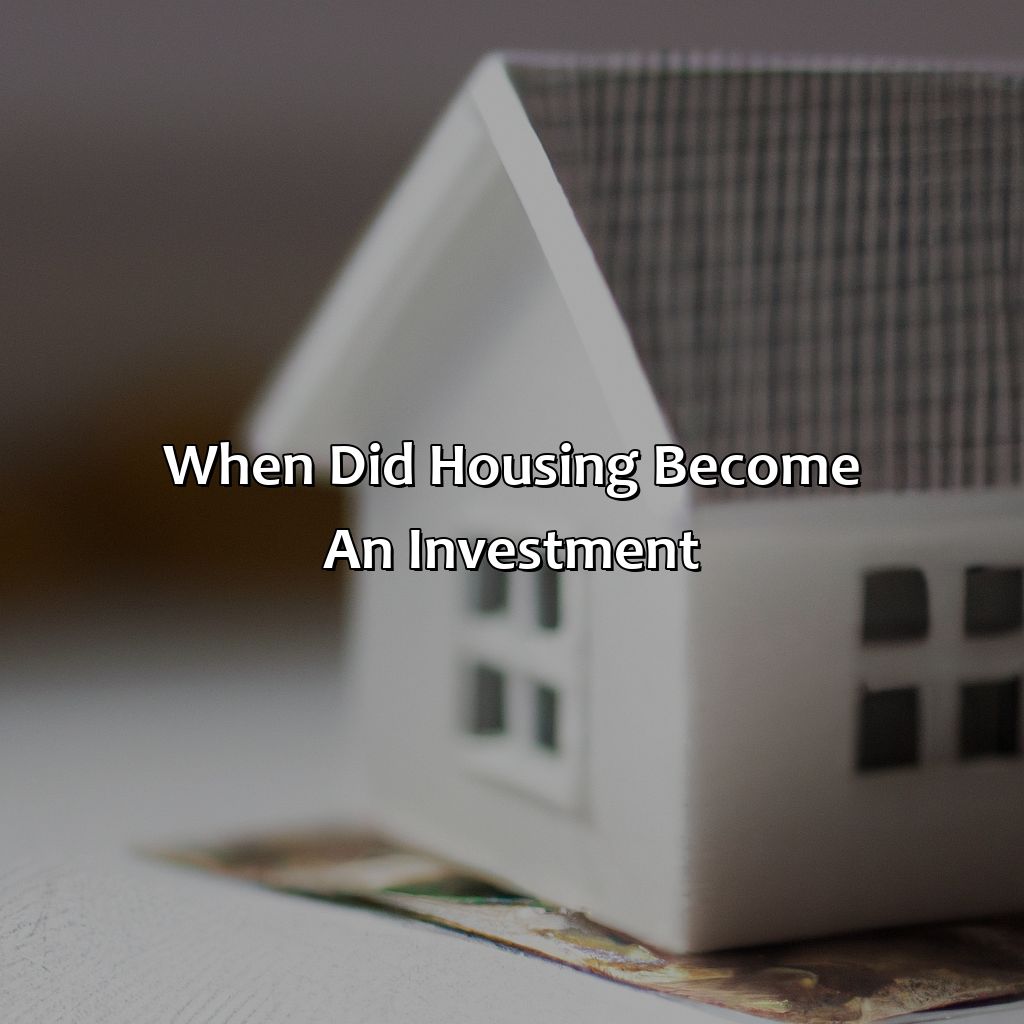When Did Housing Become An Investment?
Key Takeaway:
- Homeownership has been a part of American life since colonial times, but it was not until the 20th century that homeownership became a key component of building personal wealth and investment.
- The post World War II era saw an influx of new homeownership policies, including the creation of the Federal Housing Administration and the GI Bill, which made it easier for Americans to buy their own homes and began the trend of viewing housing as an investment.
- In recent years, the housing market has seen significant fluctuations, with the 2008 financial crisis serving as a reminder of the risks associated with homeownership as an investment. However, despite these challenges, homeownership remains an important part of American life and an attractive investment opportunity for many.
Do you want to discover when and how housing became an investment? This article looks into the history of the housing market and how it has evolved into an investment opportunity. Uncover the secrets of how and when housing became an investment and equip yourself with this valuable knowledge.
History of Homeownership
Want to understand the story of homeownership? Dive into the past with this section. It’s called “History of Homeownership“. It includes topics like:
- “Early Development of Homeownership”
- “The Industrial Revolution and Homeownership”
- “Post World War II and Homeownership”
Discover the evolution of homeownership and its importance in different periods of history.

Image credits: retiregenz.com by Adam Jones
Early Development of Homeownership
The origins of property ownership can be traced back to ancient times, where it was primarily used for agricultural purposes. However, as civilization progressed and societies became more complex, homeownership evolved into a desirable status symbol that represented stability and security. It was only in the late 19th century that owning a home began to be considered as a potential investment opportunity, giving rise to the idea of real estate as an asset class. The causes and implications of this shift are fascinating.
The transformation of homeownership from utilitarian use to a status symbol laid the foundation for its development into an investment vehicle. By investing in property, investors could profit from rising land values and rental incomes. This sparked widespread interest among middle-class households who saw homeownership as a means to financial stability. As more people invested in property, governments around the world launched initiatives to encourage homeownership; thus setting in motion the phenomenon we now call “the property ladder.”
One interesting aspect is how this trend impacted social dynamics. Homeownership became closely linked with upward mobility; aspiring individuals worked hard to achieve steep financial targets such as saving for down payments or covering mortgage installments on time. Those who failed felt left behind- excluded from mainstream society which further reinforced the perception that owning property was a crucial ingredient for success.
Today’s housing market remains fiercely competitive with dynamic price points driven by ever-changing economic circumstances -the current global pandemic has only amplified these trends. Homeownership continues its transformational journey shaped by various stakeholders including policymakers, investors and buyers themselves- where will it head next?
Back in the Industrial Revolution, homeownership was like owning the latest iPhone – you showed it off to everyone and still had no idea how it actually worked.
The Industrial Revolution and Homeownership
During the Industrial Revolution, there was a surge in homeownership as people sought out stable places to live amidst widespread urbanization. The availability of affordable housing and the rise of real estate markets also made it increasingly attractive to own property. As home ownership became more common, it began to take on the role of not only a shelter but also an important investment opportunity.
With increasing access to mortgage financing, owning a home became seen as a way to build wealth through appreciation in property values. This led to innovative financial instruments like mortgages and bonds that were based on actual properties which amplified the potential return on investment. Homeownership has since become one of the most widely recognized paths to financial security for the middle class.
It is worth noting that while homeownership is often touted as an excellent investment opportunity, it can be difficult and risky for some individuals without proper financial planning or circumstances may not allow them to engage in this venture fully.
Pro Tip: Owning a home can be financially rewarding, but don’t forget about other investments such as diversification across assets and geographies.
With the end of World War II came not only victory, but also the chance for returning soldiers to fulfill their dreams of white picket fences and mortgage payments.
Post World War II and Homeownership
During the Post-WWII era, there was a remarkable increase in homeownership rates due to government policies and economic growth. This led to more people having access to affordable housing, resulting in a surge of people purchasing homes as an investment. As a result, homeownership became a significant source of wealth accumulation in America.
In addition to this, the rise of suburbanization during this period enabled families to move out of urban areas and into newly developed neighborhoods with larger homes and yards. As more people started purchasing homes, the real estate market boomed, further cementing homeownership as an essential part of the American Dream.
One unique aspect of Post-WWII homeownership is the creation of the Veterans Administration (VA). The VA assisted veterans in buying homes by providing them with low-interest mortgages and down payment assistance. This helped many veterans become homeowners easily and cheaply.
Pro Tip: Understanding the history of when housing became an investment can shed light on how homeownership has contributed to wealth inequality in America today. When it comes to homeownership and investment, the only guarantee is that the bank always wins.
Homeownership and Investment
To understand homeownership as an investment, we need to delve further than just the basic desire for shelter. Let’s explore:
- “When Did Housing Become an Investment?”
- “Homeownership and Investment”
- “Factors That Contributed to Homeownership as an Investment,”
- “Changes in Public Policies”
- and the “Impact on the Housing Industry”
This will provide us with a deeper insight into this phenomenon.

Image credits: retiregenz.com by Yuval Duncun
Factors That Contributed to Homeownership as an Investment
The Evolution of Housing from a Place to Live to an Investment
Housing had been more than just a roof over one’s head since the 19th century. Nowadays, owning a house has become an investment or even an asset. Multitudes of factors influenced housing as an investment. The most prominent ones were changing socio-economic conditions, liberalization of finance laws, tax policies and demographic changes.
Factors like scarcity of land, increase in urbanization have led to skyrocketing property prices in recent times thus resulting in soaring returns for investors. Also, the way mortgage loans became easily accessible adding fuel to investors’ efforts paved the way for housing as an investment.
A number of other factors such as government regulations also play an important role in shaping residential property markets. Other key drivers include favorable economic trends such as low-interest rates and strong job creation figures.
Emerging fintech firms and real estate technology platforms present homebuyers with diversified home deal options besides buying them straightout; these include fractional ownership models and direct investments that provide them with reduced risks coupled with steady cash flows.
For instance, right after World War II, veterans returning enjoyed what was termed as the “G.I Bill” benefits which could facilitate their house payments resulting in growth in homeownership rates across America.
Public policies are like a game of Jenga – one wrong move and the entire housing market comes tumbling down.
Changes in Public Policies
Public policies have been instrumental in reshaping how housing has been viewed as an investment. Changes in the laws and regulations pertaining to housing have created new opportunities and challenges for homeownership and investing. The impact of policies such as zoning, tax reforms, subsidized loans, and incentives for developers have changed the perception of housing from a basic need to an asset class.
As public policies incentivized homeownership by offering tax deductions on mortgage interests, purchasing a home became more accessible to many middle-class families. Homeownership started to be treated as a means to create wealth through equity appreciation rather than as a necessity. Additionally, government programs like Fannie Mae and Freddie Mac were established in 1938 to promote residential lending by purchasing mortgages from banks, creating secondary markets where mortgages could be traded among investors.
The increased focus on homeownership may also lead to systemic risks as evidenced during the financial crisis of 2007-08. Many people had over-leveraged on their homes which were bought with low down-payment or no deposit investments resulting in foreclosures when home values dropped.
Pro tip: It is essential to understand that homeownership is not always a sound investment strategy but depends on other factors such as location, demographics, economic growth prospects that factor into home prices movements.
Looks like housing has gone from a basic necessity to a Wall Street commodity faster than you can say ‘mortgage-backed securities’.
Impact on the Housing Industry
Housing’s transformation from a basic need into an investment altered the Housing Industry’s landscape. Rapid price escalation and low supply have intensified demand, making it difficult for first-time homebuyers to enter the market. This has created wealth disparities, lowered homeownership rates, and increased rental costs.
The traditional American Dream of homeownership has been undermined by housing becoming an investment. The inability of many citizens to buy homes has led to lifestyle changes as more people become renters. While this shift can provide flexibility it exacerbates the oversupply and unaffordability of rentals.
It is crucial to understand how housing became an asset class and determine how society will address these challenges posed by its modern iteration in the investment community.
According to Anthony Alofsin at The Conversation, “Home ownership as a sign of economic stability is no longer universal.”
Five Facts About When Did Housing Become an Investment:
- ✅ Housing has been considered a form of investment for centuries, but the modern concept of buying homes as investments gained traction in the 1950s and 1960s. (Source: Investopedia)
- ✅ The US government’s promotion of homeownership, through policies such as tax deductions for mortgage interest, played a significant role in the rise of housing as an investment. (Source: The Balance)
- ✅ In the early 2000s, the housing market experienced a bubble due to lax lending standards and speculation, leading to a major crash in 2008. (Source: Business Insider)
- ✅ Despite the risks involved, housing remains a popular investment option for individuals and institutions alike, with many utilizing strategies such as rental income and flipping properties for profit. (Source: Forbes)
- ✅ The COVID-19 pandemic has caused significant disruptions in the housing market, with fluctuations in home prices and changes in housing preferences affecting investment decisions. (Source: New York Times)
FAQs about When Did Housing Become An Investment?
When did housing become an investment?
Housing has been a form of investment for centuries, but it wasn’t until the mid-20th century that housing became a mainstream investment vehicle.
What caused housing to become an investment?
The post-World War II economic boom and the growth of the middle class led to an increase in demand for housing. This, combined with government policies such as the GI Bill and federally-insured loans, made it easier for people to buy homes and sparked a housing boom that turned homes into investments.
How did the housing market change once it became an investment?
The shift to viewing homes as investments led to a greater focus on home values and appreciation, and less emphasis on housing as a form of shelter. This, in turn, led to speculation, unsustainable home price growth, and ultimately, the housing bubble and financial crisis of 2008.
Is housing a good investment?
Housing can be a good investment for some people, especially those who can buy at the right time and in the right location. However, it is not always a guaranteed or stable investment, and should not be relied on as a primary source of income or retirement planning.
What are some of the risks associated with investing in housing?
Some of the risks associated with investing in housing include market volatility, changes in interest rates, unexpected expenses such as repairs or maintenance, and the potential for rental income to decline or cease altogether. Additionally, housing prices can be affected by economic and political factors, making it a potentially unpredictable investment.
Can I include my primary residence as an investment in my portfolio?
While home equity can be a source of wealth, it’s not typically included as part of an investment portfolio in the traditional sense. It is important to remember that a primary residence is a place to live, and should not be relied upon solely as an investment.
